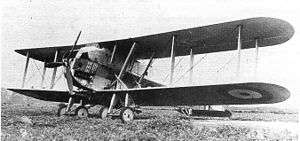Blackburn Cubaroo
The Blackburn T.4 Cubaroo was a prototype British biplane torpedo bomber of the 1920s. Built by Blackburn Aircraft and intended to carry a large 21 in (533 mm) torpedo, the Cubaroo was one of the largest single-engined aircraft in the world at the time of its first flight.
| T.4 Cubaroo | |
|---|---|
 | |
| Role | Torpedo Bomber |
| Manufacturer | Blackburn Aircraft |
| Designer | F A Bumpus |
| First flight | 1924 |
| Status | Prototype |
| Primary user | Royal Air Force |
| Number built | 2 |
Design and development
In 1921, the British Air Ministry issued Specification 8/21 to Blackburn for a Coastal Defence Torpedo Aeroplane, the resulting design being the T.4 Cubaroo. Due to the change of policy in the Air Ministry to favour a twin-engined design a new specification was issued in 1922, the British Air Ministry drew up Specification 16/22, for a long-range torpedo bomber capable of carrying a 21 in (533 mm) torpedo (which was at the time thought capable of sinking the largest warship) over a range of 800 mi (1,300 km).[1] Major F. A Bumpus, chief designer of Blackburn Aircraft submitted the design for the Blackburn T.4 Cubaroo, which was a large biplane powered by a single example of the new 1,000 hp (750 kW) Napier Cub engine. Avro also submitted a design against this specification, the Avro 557 Ava, which was a similarly large biplane, powered by two 600 hp (450 kW) Rolls-Royce Condor engines.
To carry the heavy (over 2,000 lb/907 kg) torpedo over a long range, the Cubaroo was massive. With a wingspan of 88 ft (27 m), it may have been the largest single-engine military aircraft in the world at the time and was fitted with the most powerful aircraft engine available, the Napier Cub, which was an unusual X-type engine which weighed over a ton excluding radiators.[1][2] The Cubaroo, with a mainly metal structure, had a deep fuselage to accommodate the Cub engine and was fitted with folding, two-bay wings. To carry the torpedo, the Cubaroo was fitted with a main undercarriage comprising two sets of two wheels, with the torpedo being carried on a crutch between them.
Operational history
The first prototype (with serial N166) flew in secrecy in the summer of 1924, proving to have good handling characteristics, with the engine not causing problems (the Cub had already been test flown in an Avro Aldershot testbed).[1] It was then fitted with a metal, three-blade adjustable-pitch propeller and was delivered for testing at RAF Martlesham Heath but was written off after its undercarriage collapsed on 2 February 1925. A second prototype flew in 1925, but the Air Ministry abandoned the requirement for a torpedo bomber to carry the 21 in (533 mm) torpedo and lost interest in single-engine heavy bombers, so the second prototype Cubaroo was used as an engine testbed, flying with the experimental 1,100 hp (820 kW) Beardmore Simoon compression ignition engine.[1]
Specifications (Cubaroo)
Data from The British Bomber since 1914 [1]
General characteristics
- Crew: 4 (pilot, navigator, bomb-aimer/gunner and midships gunner)
- Length: 54 ft 0 in (16.46 m)
- Wingspan: 88 ft 0 in (26.82 m)
- Height: 19 ft 4 in (5.89 m)
- Empty weight: 9,632 lb (4,369 kg)
- Max takeoff weight: 19,020 lb (8,627 kg)
- Powerplant: 1 × Napier Cub X-16 water-cooled piston engine, 1,000 hp (750 kW)
- Propellers: 2-bladed fixed-pitch propeller
Performance
- Maximum speed: 115 mph (185 km/h, 100 kn)
- Range: 1,800 mi (2,900 km, 1,600 nmi)
- Endurance: 10 hours[3]
- Service ceiling: 11,800 ft (3,600 m)
Armament
- 3 × .303 in (7.7 mm) Lewis Guns in midship gunners cockpit and at beam hatches
- 1 × 21 in (533 mm) naval torpedo
or
- 4 × 551 lb (250 kg) bombs
References
- Mason, Francis K (1994). The British Bomber since 1914. London: Putnam Aeronautical Books. ISBN 0-85177-861-5.
- Lewis, Peter (1980). The British Bomber since 1914 (3rd ed.). London: Putnam. ISBN 0-370-30265-6.
- "Blackburn Aircraft: A Tribute to a great Yorkshire family". Flight International. Vol. 78 (No. 2633): p.p.602-613. 1 May 1959.
Further reading
- "THE BLACKBURN-NAPIER "CUBAROO" A Long-Distance Torpedo-'Plane with 1,000 H.P, Napier "Cub" Engine". Flight. Vol. XVI (No. 35) (No. 818): p.p.537-539. 28 August 1924.
External links
| Wikimedia Commons has media related to Blackburn Cubaroo. |
- "Blackburn Cubaroo". British Aircraft Directory. 7 August 2004. Archived from the original on 30 September 2007. Retrieved 21 June 2020.